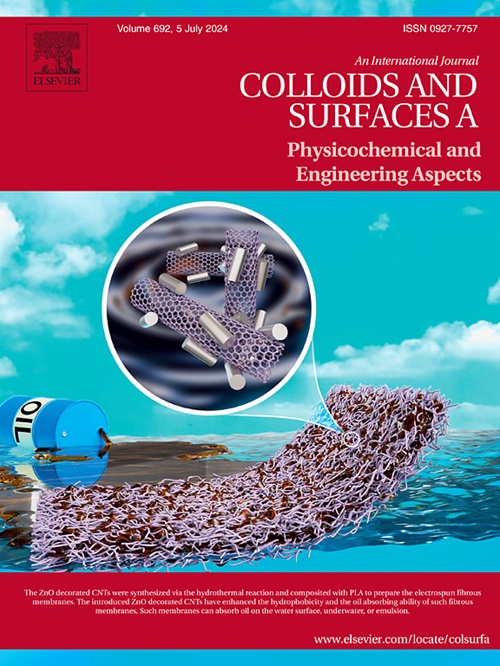通过超分子交联网络提高可持续生物质基胶粘剂的性能
IF 4.9
2区 化学
Q2 CHEMISTRY, PHYSICAL
Colloids and Surfaces A: Physicochemical and Engineering Aspects
Pub Date : 2025-05-16
DOI:10.1016/j.colsurfa.2025.137233
引用次数: 0
摘要
随着石油资源的日益枯竭和全球环保意识的显著提高,传统的石油基树脂已难以满足工业和消费者的需求,生物质基胶粘剂的开发已成为胶粘剂领域的研究热点。本研究通过胺化纤维素(AC)与柠檬酸(CA)和聚酰胺651 (PA651)的多重交联,构建了一种多重交联网络增强的生物质基粘合剂。用该胶粘剂制备的三层胶合板干强度为4.5 MPa,湿强度为3.54 MPa,经沸水处理3 h后,湿强度保持在3.11 MPa。此外,该粘合剂在木材上表现出优异的粘合性能,同时在竹、钢、铝、铜、玻璃、聚四氟乙烯(PTFE)、聚氯乙烯(PVC)和其他工程材料上也表现出有效的粘合能力。本工作创新性地采用无甲醛交联技术,通过绿色化工工艺技术路线取代传统的甲醛基交联剂,有效解决了生物质基胶粘剂耐水性不足、粘接强度低等关键技术难题。本文以纤维素为生物质原料,通过共价/非共价交联网络的协同增强策略,为工业胶粘剂领域生物质胶粘剂的可持续发展提供新的技术解决方案。本文章由计算机程序翻译,如有差异,请以英文原文为准。
Enhancing performance of sustainable biomass-based adhesive through supramolecular crosslinked networks
With the increasing depletion of petroleum resources and the significant increase in global environmental awareness, traditional petroleum-based resins have been difficult to meet the needs of industry and consumers, and the development of biomass-based adhesives has become the research focus in the field of adhesives. Here, a multiple crosslinked network-enhanced biomass-based adhesive was constructed by multiple cross-linking of aminated cellulose (AC) with citric acid (CA) and polyamide 651 (PA651). The three-layer plywood prepared with this adhesive exhibited a dry strength of 4.5 MPa with a wet strength of 3.54 MPa, which remained at 3.11 MPa after 3 h of boiling water treatment. Furthermore, the adhesive exhibited excellent adhesive performance on wood, while also demonstrated effective bonding capabilities for bamboo, steel, aluminum, copper, glass, polytetrafluoroethylene (PTFE), polyvinyl chloride (PVC), and other engineering materials. This work innovatively adopts formaldehyde-free cross-linking technology to replace the traditional formaldehyde-based cross-linking agent through the green chemical process technology route, which effectively solves the key technical problems such as insufficient water resistance and low bonding strength of biomass-based adhesives. In this work, cellulose was used as a biomass raw material to provide a new technological solution for the sustainable development of biomass adhesives in the field of industrial adhesives through a synergistic enhancement strategy of covalent/non-covalent crosslinking networks.
求助全文
通过发布文献求助,成功后即可免费获取论文全文。
去求助
来源期刊
CiteScore
8.70
自引率
9.60%
发文量
2421
审稿时长
56 days
期刊介绍:
Colloids and Surfaces A: Physicochemical and Engineering Aspects is an international journal devoted to the science underlying applications of colloids and interfacial phenomena.
The journal aims at publishing high quality research papers featuring new materials or new insights into the role of colloid and interface science in (for example) food, energy, minerals processing, pharmaceuticals or the environment.

 求助内容:
求助内容: 应助结果提醒方式:
应助结果提醒方式:


